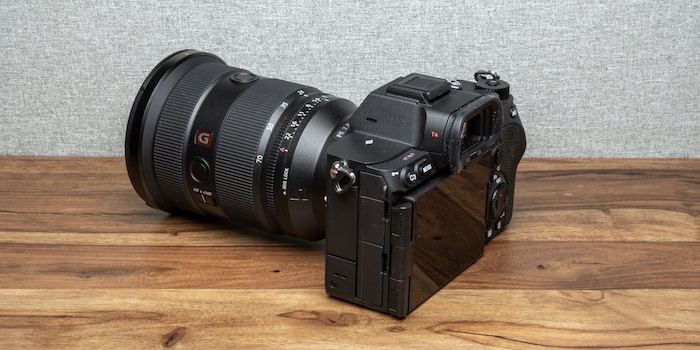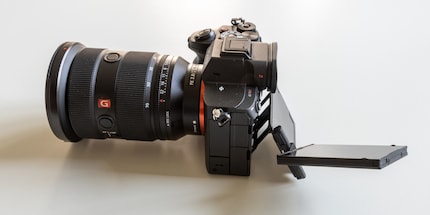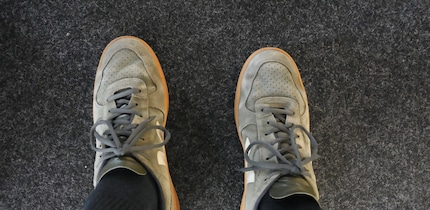

Sony A7R V with 8K and a dual-motion screen
Of all things, Sony does not increase the resolution of its resolution flagship. Nevertheless, the fifth edition of the Alpha 7R offers some interesting innovations. I was already able to get a first impression.
The "R" in the name of the Sony A7R stands for Resolution. In the Sony line-up, it is the camera with the highest resolution. Now comes version V of the A7R - but the resolution is not increased. It remains at 61 megapixels. Instead, Sony has improved various other points, from the screen to the viewfinder to the image stabiliser.
Better image stabilisation
The built-in image stabiliser, according to Sony, now compensates for up to eight exposure stops instead of five and a half stops as in the predecessor. A powerful image stabiliser is important in a high-resolution camera, as even the slightest shake is noticeable. I cannot check whether there are really eight stops, but the difference between the stabiliser being on and off is very clear.
Here is a detail from a photo with a focal length of 24 millimetres and a half-second exposure time.

For comparison, a shot with the same settings but without image stabiliser.

Video at 8K and 4K50
A lot has happened in video in the last three years, so its predecessor A7R IV is no longer up to date. For example, it can only shoot 4K at a maximum of 30 frames per second (FPS) and 8K doesn't work at all. The A7R V is different: it can shoot 4K at up to 60 FPS and 8K is also possible, at 24 or 25 FPS. These newly added modes, however, result in a slightly narrower frame (crop factor 1.2).
.
High frame rates at 4K are computationally intensive, so cameras can overheat. Sony says it has improved heat dissipation. Still, 4K50 or 4K60 uses pixel binning, not oversampling. Oversampling is more computationally intensive, but of higher quality. In my short hands-on, however, even the shots with pixel binning were very sharp.
Better viewfinder, more versatile screen
The new camera's viewfinder comprises 9.4 million pixels, up from 5.76 million on the A7R IV. This puts it on par with the Alpha 1 and the Alpha 7S III. At 61 megapixels, this improvement is particularly welcome - after all, you also want as much resolution as possible in the viewfinder to judge sharpness.
By the way, these figures are sub-pixels. The number of pixels is only a third as high. In pixels, the resolution of the viewfinder is 2048 × 1536.
On the screen, Sony combines two different movement mechanisms. On the one hand, the screen can be turned out sideways by 180 degrees and then rotated around its own axis, as is popular for video recording. At the same time, the screen can also be pulled out and then rotated upwards to look at it from above. This mechanism is less flexible, but faster.

Autofocus gets a bit smarter
The autofocus can now also detect insects and automatically focus on them. I find it much easier to take useful insect photos with this new feature. However, there is still room for improvement: the camera does not necessarily focus on the eyes of the insect. Since the depth of field is very shallow in the macro range, the eyes can therefore become completely blurred. In addition, the autofocus does not recognise the insect fast enough to focus on it in flight. The camera has not become faster at ten frames per second, but it keeps the speed a little longer, namely for 88 instead of 68 RAW shots.

The A7R V is also supposed to recognise people even better: With the help of artificial intelligence, the autofocus should be able to anticipate movements. The recognition of people in motion worked flawlessly in the hands-on; but this is nothing new for Sony and I can't say whether it has become much better. Like insect detection, motion anticipation is a feature that is not yet available in any other Sony camera. Both are innovations that would also be useful in other, faster Alpha cameras. It is quite possible that Sony will add them via one or another firmware update.
The autofocus also works better in APS-C mode. It now includes just as many autofocus points as in full-frame mode and also covers almost the entire image field. In APS-C mode, only the inner part of the sensor is used - mainly to be able to use lenses built for smaller sensors.
Ah, there was one more thing: image quality
Sensitivity in low light has somehow been improved, but Sony remained vague about this in advance. The manufacturer has also tweaked the colour reproduction and white balance. These are certainly not significant improvements over the predecessor.
This is an unedited image of the camera.
I shot this unprocessed JPEG at 25600 ISO. Below is a small crop of it. The camera's RAW files cannot yet be edited at the time of this hands-on because my RAW converter does not yet support the new format.

The Sony Alpha 7R is expected to be available from mid-November 2022. Also remaining available are its predecessor, the IV model, and a slightly updated version of its predecessor, the Sony A7R III A.
Conclusion: resolution potential is better utilised
The main feature of the A7R series has always been its high resolution - so at first it seems perverse not to improve that of all things. The improvements in autofocus were probably made by Sony with other cameras in mind. In this respect, the new A7R V is not quite what I expected.
The innovations are nevertheless useful and sensible. There wasn't necessarily a need for action in terms of resolution - 61 megapixels are enough for practically everything. It is more important that the resolution can be fully exploited. This requires not only high-quality lenses, but also a powerful image stabiliser and precise autofocus. The A7R V has all that.
My interest in IT and writing landed me in tech journalism early on (2000). I want to know how we can use technology without being used. Outside of the office, I’m a keen musician who makes up for lacking talent with excessive enthusiasm.
From the latest iPhone to the return of 80s fashion. The editorial team will help you make sense of it all.
Show all
